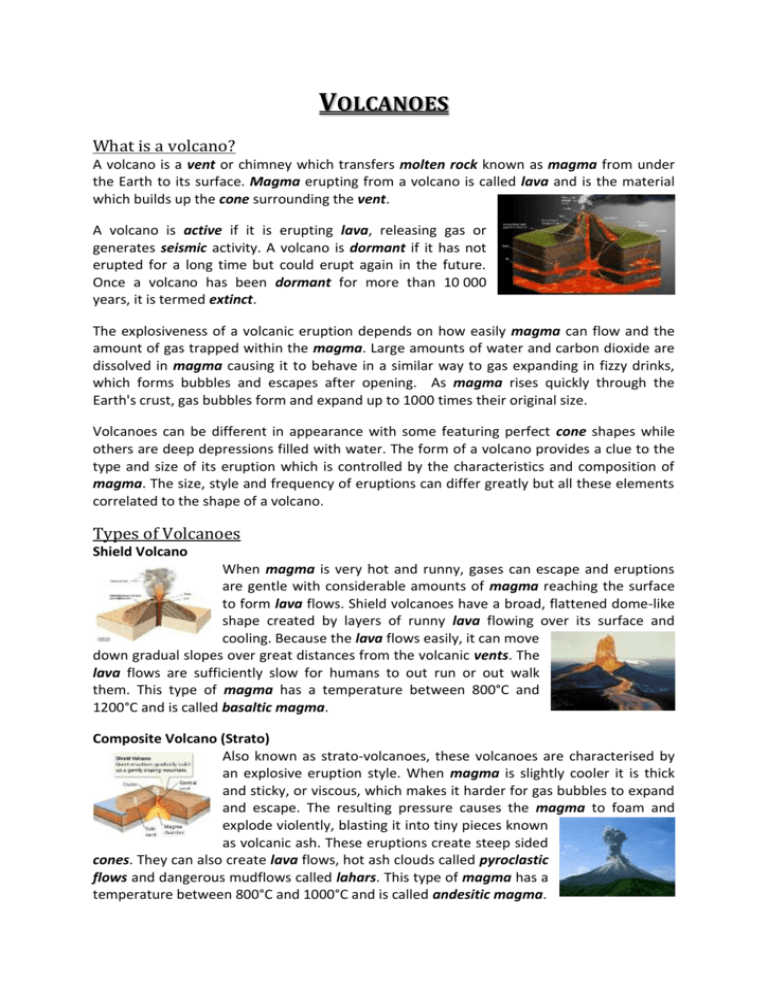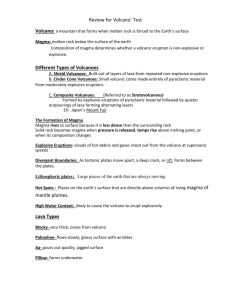Volcanoes - Science at Taylors Hill PS
advertisement

VOLCANOES What is a volcano? A volcano is a vent or chimney which transfers molten rock known as magma from under the Earth to its surface. Magma erupting from a volcano is called lava and is the material which builds up the cone surrounding the vent. A volcano is active if it is erupting lava, releasing gas or generates seismic activity. A volcano is dormant if it has not erupted for a long time but could erupt again in the future. Once a volcano has been dormant for more than 10 000 years, it is termed extinct. The explosiveness of a volcanic eruption depends on how easily magma can flow and the amount of gas trapped within the magma. Large amounts of water and carbon dioxide are dissolved in magma causing it to behave in a similar way to gas expanding in fizzy drinks, which forms bubbles and escapes after opening. As magma rises quickly through the Earth's crust, gas bubbles form and expand up to 1000 times their original size. Volcanoes can be different in appearance with some featuring perfect cone shapes while others are deep depressions filled with water. The form of a volcano provides a clue to the type and size of its eruption which is controlled by the characteristics and composition of magma. The size, style and frequency of eruptions can differ greatly but all these elements correlated to the shape of a volcano. Types of Volcanoes Shield Volcano When magma is very hot and runny, gases can escape and eruptions are gentle with considerable amounts of magma reaching the surface to form lava flows. Shield volcanoes have a broad, flattened dome-like shape created by layers of runny lava flowing over its surface and cooling. Because the lava flows easily, it can move down gradual slopes over great distances from the volcanic vents. The lava flows are sufficiently slow for humans to out run or out walk them. This type of magma has a temperature between 800°C and 1200°C and is called basaltic magma. Composite Volcano (Strato) Also known as strato-volcanoes, these volcanoes are characterised by an explosive eruption style. When magma is slightly cooler it is thick and sticky, or viscous, which makes it harder for gas bubbles to expand and escape. The resulting pressure causes the magma to foam and explode violently, blasting it into tiny pieces known as volcanic ash. These eruptions create steep sided cones. They can also create lava flows, hot ash clouds called pyroclastic flows and dangerous mudflows called lahars. This type of magma has a temperature between 800°C and 1000°C and is called andesitic magma. Caldera Volcano These erupt so explosively that little material builds up near the vent. Eruptions partly or entirely empty the underlying magma chamber which leaves the region around the vent unsupported, causing it to sink or collapse under its own weight. The resulting basin-shaped depression is roughly circular and is usually several kilometres or more in diameter. The lava erupted from caldera volcanoes is very viscous and generally the coolest with temperatures ranging from 650°C to 800°C and is called rhyolitic magma. Although caldera volcanoes are rare, they are the most dangerous. Volcanic hazards from this type of eruption include widespread ash fall, large pyroclastic surges and tsunami from caldera collapse. Volcanic Hazards Volcanic hazards include explosions, lava flows, bombs or ballistics, ash or tephra, pyroclastic flows, pyroclastic surges, mudflows or lahars, landslides, earthquakes, ground deformation, tsunami, air shocks, lightning, poisonous gas and glacial outburst flooding. Each hazard has a different consequence, although not all occur in all eruptions or in association with all volcanoes. Volcanic ash clouds can damage aircraft engines but ash is not visible by radar, the main navigation aid for aircraft. There are nine Volcanic Ash Advisory Centres around the world which use satellites to help track volcanic ash clouds and provide warnings for aircraft. Measuring Volcanic Eruptions Volcanic eruptions are measured using a simple descriptive index known as the Volcano Explosivity Index which ranges from zero to eight. The index combines the volume of material ejected with the height of an eruption column and the duration of the eruption. Predicting Eruptions Volcanic eruptions are very hard to predict as they can erupt without giving any signals beforehand. A volcano’s eruptive history may provide good clues as to the size and violence of the next eruption for that volcano. Typically, long periods between eruptions may show that a volcano’s next eruption will be large and explosive. One problem with using eruptive history to predict a future event is that only a small number of the world’s volcanoes have a known history. Earthquake activity around a volcano indicates that magma is moving below a volcano and so can precede an eruption. However, eruptions can occur with no change to seismic activity. Changes in the surface shape may show that magma is rising beneath a volcano. Keeping track of tiny changes such as bulging can forecast an eruption. Temperature changes in surface lakes or the ground water near a volcano can be a good early detection tool of an eruption. However, not all temperature changes are related to volcanic eruptions. Where do Volcanoes Occur? Active volcanoes generally occur close to the major tectonic plate boundaries. Many are located along the Earth's plate boundaries. Active volcanoes are rare in Australia because there are no plate boundaries on this continent. However, there are two active volcanoes located 4,000 kilometres south west of Perth on the Australian territories, Heard Island and the nearby McDonald Islands. The other active volcanoes nearest Australia are in New Zealand, Papua New Guinea, Indonesia and the Philippines. Gas-rich sticky magmas dominate the Asia Pacific, making composite volcanoes and calderas the most common varieties in the region. These types of volcanoes severely threaten lives, property, agricultural lands and lifelines throughout south east Asia and the Australian region. VOLCANO GLOSSARY active volcano A volcano that is erupting. Also, a volcano that is not presently erupting, but that has erupted within historical time and is considered likely to do so in the future. andesitic magma A type of magma with intermediate viscosity and silica content. basaltic magma It is primarily made of the rock called basalt which is a rock found deep within the earth so basaltic magma comes from deep inside. Basaltic flows are the hottest. volcanic cone A volcanic cone is the cone-shaped hill formed as material from volcanic eruptions piles up around the volcanic vent, or opening. dormant volcano erupt/eruption extinct volcano A volcano which is presently inactive but which may erupt again. The process by which solid, liquid, and gaseous materials are ejected into the earth's atmosphere and onto the earth's surface by volcanic activity. A volcano that is not presently erupting and is not likely to do so for a very long time in the future. lahars Mud flow of water and volcanic material commonly caused by the bursting of a crater lake, eruption from a snowcapped volcano or from prolonged torrential rain. lava Magma which has reached the surface through a volcanic eruption. The term is most commonly applied to streams of liquid rock that flow from a crater or fissure. It also refers to cooled and solidified rock. magma Molten rock beneath the surface of the earth. magma chamber The subterranean cavity containing the gas-rich liquid magma which feeds a volcano. molten rock rock liquefied by heat pyroclastic Pertaining to fragmented rock material formed by a volcanic explosion or ejection from a volcanic vent. pyroclastic flow Lateral flowage of a turbulent mixture of hot gases and unsorted pyroclastic material that can move at high speed. The term also can refer to the deposit so formed. rhyolitic magma A type of highly viscous magma with high silica content. seismic Relates to vibrations of the earth and its crust. tectonic plates Tectonic plates are large plates of rock that make up the foundation of the Earth's crust and the shape of the continents. tephra Tephra is a general term for fragments of volcanic rock and lava regardless of size that are blasted into the air by explosions or carried upward by hot gases in eruption columns or lava fountains. volcanic vents Vents are the locations from which lava flows and pyroclastic materials are erupted. Volcano Explosivity Index (VEI) The Volcanic Explosivity Index was devised by Chris Newhall and Stephen Self in 1982 to provide a relative measure of the explosiveness of volcanic eruptions viscous/viscosity The ability of a liquid to flow.







